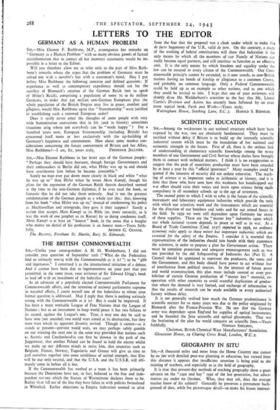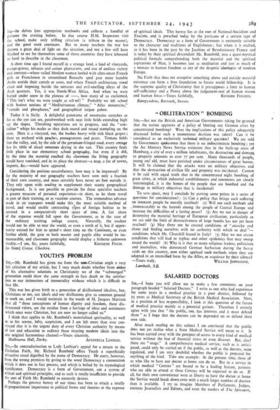GEOGRAPHY IN SITU
Snt,—A thousand miles and more from the Home Country one cannot be au fait with detailed post-war planning in education, but viewed from this distance it appears that insufficient attention is being paid to the training of teachers, and especially so in the field of geography.
It is true that present-day methods of teaching geography show a great advance on the " cape and bay " type of the last generation, but educa- tionists are under no illusions. What, they may ask, does the average teacher know of his subject? Generally he possesses a permanent back- ground of data, while for picturesque detail—to make his lesson interest-
ing—he delves into appropriate textbooks and collects a handful of pictures the evening before. In due course H.M. Inspectors visit the school, make only trifling criticism (a tribute to the master), and the good work continues. But to many teachers the war has thrown a great deal of light on the situation, and not a few will have blushed to see for themselves some of those countries they have laboured so hard to describe in the classroom.
A short time ago I found myself in a strange land, a land of vineyards, orange-groves, tobacco and cotton plantations, and one of endless variety and contrast—where veiled Moslem women jostled with ultra-smart French girls or Frenchmen in streamlined Renaults sped past more humble Arabs astride their camels or asses, and where French architecture stood clean and imposing beside the tortuous and evil-smelling alleys of the Arab quarters. Yes, it was North-West Africa. And when we were buried under snow in the plateau of —, how many of us exclaimed, " This isn't what we were taught at sch3ol! " Probably we left school with haziest notions of " Mediterranean climate," " Atlas mountains," "cereals and phosphates," and geographical jargon galore.
Today it is Sicily. A delightful panorama of mountains stretches as far as the eye can see, patchworkcd with neat little fields extending high up the slopes. Threshing operations are in progress, and the " con- tadino " whips his mules as they dash round and round trampling on the corn. Here is a vineyard, too, the bushes heavy with rich black grapes ; there an orchard with peaches, pomegranates and pears. Tomato fields line the valley, and, by the side of the geranium-fringed road, every cottage has its table of sliced tomatoes drying in the sun. This country finds little place in our elementary school geography, but even if it did, by the time the material' reached the classroom the living geography would have vanished, and in its place the abstract—a map, a list of towns, imports, &c.—would have appeared.
Considering the position unsatisfactory, how may it be improved? By far the majority of our geography teachers have seen only a fraction of their, own country, and most certainly have never set foot outside it. They, rely upon wide reading to supplement their scanty geographical background. Is it not possible to provide for these specialist teachers a greater measure of personal experience—in short, to let them travel as part of their training, or as vacation courses. The tremendous advance made in air transport• would make this the most suitable method of travel, and would enable contrasting types of foreign habitat to be covered in a comparatively short space of time. A, fair share of the expense would fall upon the Government, as in the case of
the ordinary training college course. Naturally, the student would not be able to tour the -world, or even a tenth of it, but if oppor- tunity existed for him to spend' a short time on the Continent, or even further afield, the gain to both master and pupils alike would be im- measurable, and classroom geography would display a hitherto unknown vitality.—I am, Sir, yours faithfully, KENNETH FINCH. las from] Crewe, Cheshire.



























 Previous page
Previous page